Welcome! Ready to discover the charms of Sasebo? Nestled in the northwestern part of Kyushu, this quaint city in Nagasaki Prefecture offers a surprising blend of scenic beauty, unique cultural experiences, and a hint of American flair thanks to its long-standing naval base. Whether you’re a nature lover drawn to its picturesque islands or a foodie eager to taste its famous Sasebo burgers, this city promises a journey full of unexpected delights. Let’s dive into what makes Sasebo a must-visit for those looking to explore off the beaten path in Japan.
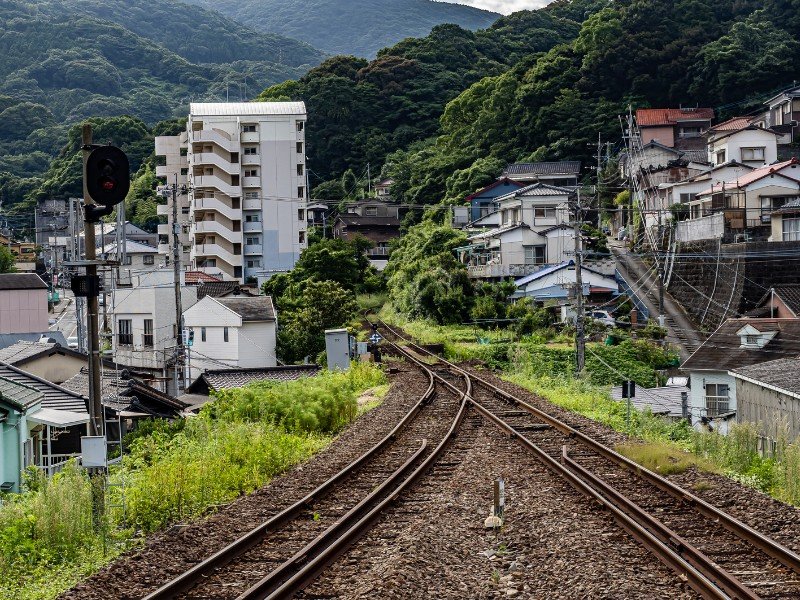
Natural Wonders
Island Hopping Adventures: Sasebo is the gateway to over 200 islands that make up the Kujuku Islands. These stunningly beautiful islets are perfect for leisurely cruises, kayaking, and photography, especially at sunset when the sky and sea blend in a spectacular display of colors.
Huis Ten Bosch: Just a stone’s throw from the city center, this expansive Dutch-themed park recreates a Netherlands town with meticulous detail. It’s not only a feast for the eyes but also offers a range of attractions, including seasonal flower gardens, amusement rides, and cultural festivals. It’s perfect for a family day out or a romantic evening stroll under illuminated trees.
Culinary Delights
Sasebo Burgers: No visit to Sasebo is complete without trying a Sasebo Burger. This local specialty, born from the American naval presence, has been perfected by various eateries around the city to offer a gourmet twist on the classic American burger. Juicy, hefty, and customizable, these burgers are a must-try for any visitor.
Seafood and More: Given its coastal location, Sasebo’s seafood is fresh and abundant. Enjoy sushi and sashimi that’s just been pulled from the water or try champon, a Nagasaki noodle dish that’s popular in the area, rich with seafood and savory broth.
Cultural Insights
Seaside Promenade and Historical Walks: Walk along the Miura-machi and Sasebo-machi districts where old-fashioned shops and traditional buildings paint a picture of Sasebo’s rich history. The city’s unique blend of Japanese and American influences can be felt as you stroll through these bustling streets.
Navy Day: Experience Sasebo’s naval traditions during Navy Day, when the Japan Maritime Self-Defense Force opens its base to the public. It’s a rare opportunity to see modern naval ships up close and learn about Sasebo’s strategic military significance.
Why Sasebo?
Sasebo might not boast the neon buzz of Tokyo or the ancient temples of Kyoto, but its charm lies in its low-key allure and the variety of experiences it offers. So pack your bags, bring your appetite, and prepare for an adventure that will leave you richer in experiences and stories.
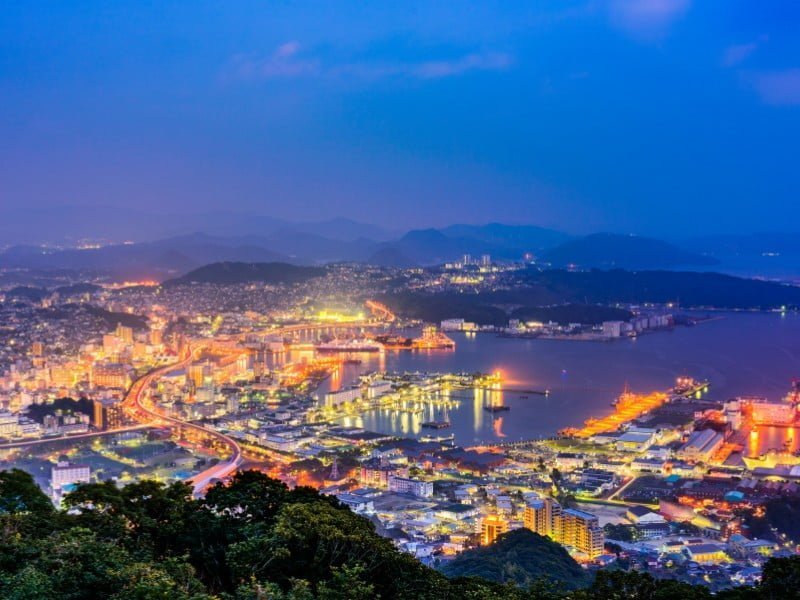
Sasebo City Guide: A Brief History Of Sasebo, Japan
Curious about what shaped Sasebo into the vibrant city it is today? Sasebo’s history is as colorful as its landscapes, marked by its strategic location, military significance, and cultural amalgamation. Let’s take a stroll through time to uncover the layers of history that have defined this unique Japanese city.
Strategic Beginnings
A Naval Powerhouse: Originally a small fishing village, Sasebo’s fate changed dramatically in 1886 when the Imperial Japanese Navy recognized its strategic importance. Nestled in a perfect natural harbor, the city rapidly transformed into a major naval base. This development shaped much of its modern history, influencing its infrastructure and cultural fabric.
War and Reconstruction
Wartime Impact: During World War II, Sasebo became a significant naval base for operations in the Pacific, making it a target for bombing raids. The war left profound marks on the city, with many areas needing extensive rebuilding. Post-war recovery was swift, aided by American forces who established a presence in the city, influencing its culture and economy significantly.
American Influence
Cross-Cultural Exchange: The establishment of the U.S. Naval Base in 1946 introduced a wave of American culture to Sasebo. This influence is most deliciously observed in the local cuisine, particularly the Sasebo Burger, which has become a symbol of cultural synthesis. The presence of American personnel and their families brought new customs and economic opportunities, which helped reshape the city’s social landscape.
Cultural Renaissance
Preserving and Celebrating Heritage: In recent decades, Sasebo has embraced its historical roots and cultural heritage with open arms. The city celebrates its naval history with annual festivals like the Sasebo Naval Port Festival, which draws visitors and military enthusiasts alike. Efforts to preserve historical sites, including wartime buildings and traditional Japanese architecture, are robust, reflecting a community proud of its past and optimistic about its future.
Today’s Sasebo
A Modern-Day Melting Pot: Today, Sasebo is more than just a military town. It’s a thriving city known for its unique blend of Japanese and Western influences. This cultural melting pot is evident in its diverse attractions, from the cosmopolitan feel of its downtown areas to the serene beauty of the Kujuku Islands. Sasebo’s historical narrative continues to evolve, making it a fascinating destination for historians, tourists, and locals alike.

Sasebo Top Attractions and Best Places to Visit in Japan
Home to an American military base in the present day, Sasebo is a destination that is remarkably friendly to English speakers.
While in the area, check out its gorgeous islands, museums, and a theme park that will make you wonder if you stepped through a portal to Holland.
Sasebo is situated in Nagasaki Prefecture; during the Edo Period, only three foreign nations were allowed to trade in the port of Nagasaki – China, Korea, and the Netherlands. Over the centuries, this part of Japan was exposed extensively to Dutch culture – this explains the existence of Huis Ten Bosch, a Dutch-themed theme park that attracts throngs of Japanese on a yearly basis.
Taking its name from one of the palaces of the Dutch Royal Family, this park recreates a Dutch town, complete with every Dutch cliche you can think about regarding this nation. Filled with traditional Dutch architecture, flower beds filled with tulips, and windmills, this place feels about as far away from traditional and modern Japan as you can get.
In addition to the hotels and restaurants contained within the park, you’ll find a number of amusements – these include 3D theatres, a haunted house, a Ferris Wheel, and a recreation of the famous Dom Tower of Utrecht.
Back in the city of Sasebo, make time to check out the Maritime Self-Defense Force Museum. As the name suggests, this institution focuses on telling the history of the Japanese navy.
More Attractions
In addition to exhibits which build a bridge from the fleets of the past to today’s navy, there are models of ships used in previous years, as well as a boat simulator, where you can try to pilot a navy ship into the harbour of Sasebo. While some displays lack English translation, the lack of an admission charge still makes this attraction well worth a visit.
Looking for a great place to enjoy a beautiful day in Sasebo? Make your way over to the Kujukushima Pearl Sea Resort. This tourist draw boasts a number of attractions that include an aquarium, restaurants, and souvenir shops.
In the aquarium, you’ll find animals that are commonly found in the waters off Sasebo. Of them, its collection of jellyfish stands out, for there are over 100 different types of this gelatinous life form.
While Sasebo is somewhat lacking in cultural attractions, its natural beauty makes up for its deficiency in this department. After checking out everything there is to see and do at Kujukushima Pearl Sea Resort, book a cruise out to the Kujuku Islands.
Literally meaning the ‘99 islands’ in English, there are actually more than 200 of these craggy, small islets in reality. For this reason, the Kujukushima area has been inducted into the ‘Most Beautiful Bays in the World’ club, making it a cruise through these isles a must for ocean lovers.

Other Cultural Attractions: Trip to Sasebo, Japan
Japan is a nation that embraced many facets of American culture even after their defeat in World War II. Baseball was among them – soon there were leagues across the country, giving rise to a new type of athlete in this sport.
It was only a matter of time before one broke through to Major League Baseball in America – Masanori Murakami was the one who did it, starring in his first major league game for the San Francisco Giants as a reliever in 1964.
Many more followed in his footsteps, including catcher Kenji Jojima of Sasebo. It is him who graces the name of the Kenji Jojima Museum, which is dedicated to the baseball star and his rise to the major leagues. Learn about his early life and his playing career in Sasebo, in Japan’s major leagues, and his successful career in Major League Baseball for the Seattle Mariners.
Other Attractions
Take in an amazing view of Sasebo and the Kujuku Islands from the Tenkaiho Observatory. Favoured in any season for its sunset views, it is best visited during the spring and fall months for its views of canola fields and fall foliage respectively.
Exhausted after a long day spent exploring the Sasebo area? Spend some time unwinding in Nagasaki Prefectural Saikaibashi Park. While your kids play on the many structures found in its playground, relax on the grass and take in the amazing coastal views that are possible throughout this park.
Photographers should take care not to miss the whirlpools that form in the adjacent channel during changes in the tides, or the spectacular bridge that crosses it.
Christianity a minority religion in Japan – only 1-2% practice nationwide. However, that number is highest in Nagasaki prefecture, with about 5% practising thanks to missionary activities during its status as an open port during the Edo Period.
Combined with the fact that Sasebo is home to a US military base and the presence of Miuracho Catholic Church shouldn’t come as a surprise. While it is nothing too spectacular compared to other Christian places of worship around the world, it is still aesthetically pleasing inside and out and is a great place to pray if you are a believer.
source: Shinichi’s World on YouTube
Top 20 Things To Do in Sasebo, Japan For Visitors
Here are the top 20 things to do in Sasebo:
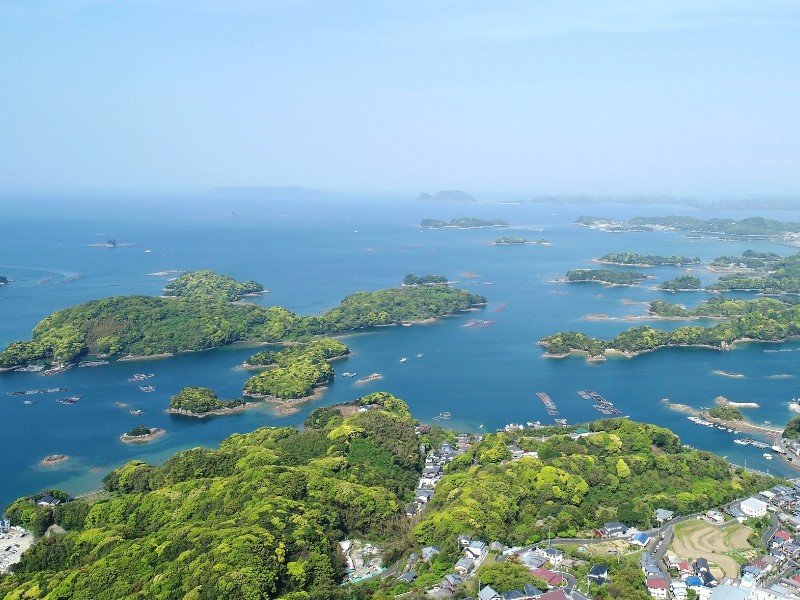
1. Explore Kujukushima Islands
Discover the breathtaking Kujukushima Islands, meaning “Ninety-Nine Islands,” a cluster of over 200 small islands dotting the coastline. Hop on a sightseeing cruise to admire their natural beauty, unique shapes, and diverse wildlife. The area, part of Saikai National Park, also offers kayaking and pearl farming tours for the adventurous. Don’t miss the Umi-Kirara Aquarium to learn more about the local marine life.
- Scenic cruises: Sail through serene waters surrounded by lush islands.
- Outdoor activities: Kayak or join a pearl farming experience.
- Marine exploration: Visit the Umi-Kirara Aquarium for aquatic wonders.
2. Visit Huis Ten Bosch
Step into a Dutch dream at Huis Ten Bosch, a theme park recreating a traditional Dutch town complete with canals, windmills, and European-style buildings. Enjoy a range of attractions, from museums and gardens to seasonal events like tulip festivals and spectacular fireworks shows. It’s a unique blend of Dutch culture and Japanese hospitality, offering entertainment for all ages. Shop, dine, and even stay overnight in themed hotels for an immersive experience.
- Cultural fusion: Experience Dutch charm in the heart of Japan.
- Seasonal events: Enjoy festivals, illuminations, and live performances.
- Themed accommodations: Stay in hotels that transport you to Europe.
3. Enjoy Sasebo Burgers
Treat your taste buds to the famous Sasebo Burger, a unique Japanese take on the American classic. Scattered throughout the city are numerous burger joints, each offering their own version of this delicious, handmade delight. Known for fresh, local ingredients and creative toppings, these burgers are a must-try. It’s a culinary adventure that foodies visiting Sasebo can’t miss.
- Local flavors: Taste burgers made with regional ingredients.
- Culinary tradition: Discover the story behind Sasebo’s burger craze.
- Foodie haven: Explore different shops to find your favorite.
4. Take a Walk in Tenkaiho Park
Soak in panoramic views at Tenkaiho Park, offering one of the best vantage points of the Kujukushima Islands. The observatory is a photographer’s paradise, especially during sunrise and sunset when the scenery is most breathtaking. Stroll through seasonal flower gardens and peaceful walking paths that provide a tranquil escape from the city. It’s the perfect spot to connect with nature and unwind.
- Spectacular vistas: Capture stunning island landscapes from the observatory.
- Seasonal beauty: Enjoy blooms like cherry blossoms and cosmos flowers.
- Peaceful retreat: Relax amidst serene surroundings.
5. Visit the Sasebo Zoological Park and Botanical Garden
Get up close with wildlife at the Sasebo Zoological Park and Botanical Garden. Home to a wide variety of animals and plant species, it’s an ideal family outing. Interact with some of the friendly animals, wander through vibrant flower gardens, and participate in educational programs. The park promotes conservation, offering both fun and informative experiences.
- Animal encounters: Meet creatures from around the world.
- Botanical wonders: Explore diverse plant life in beautiful settings.
- Educational fun: Learn about conservation efforts and wildlife.
6. Experience Mikawachiyaki Museum
Dive into the world of traditional pottery at the Mikawachiyaki Museum. Dedicated to the local Mikawachi ware, this museum showcases exquisite porcelain pieces that Sasebo is renowned for. Learn about the history and intricate production process of these beautifully crafted items. Try your hand at pottery-making workshops for a hands-on cultural experience.
- Artistic heritage: Discover the elegance of Mikawachi porcelain.
- Interactive workshops: Create your own pottery masterpiece.
- Cultural insight: Understand the craftsmanship behind the art.
7. Relax at Yumihari-no-Oka Hotel Hot Springs
Unwind in style at the Yumihari-no-Oka Hotel Hot Springs, boasting stunning views over Sasebo and the sea. Known for their therapeutic properties, these hot springs offer a relaxing experience steeped in tradition. Enjoy both indoor and outdoor baths, immersing yourself in the soothing waters. It’s the perfect way to rejuvenate after a day of exploration.
- Therapeutic relaxation: Soak in mineral-rich hot springs.
- Scenic indulgence: Bathe with panoramic ocean views.
- Cultural immersion: Experience the Japanese onsen tradition.
8. Discover the Maritime Self-Defense Force Sasebo Museum
Explore Japan’s naval history at the Maritime Self-Defense Force Sasebo Museum. With exhibits on naval history, ships, and equipment, you’ll gain insight into Sasebo’s role as a key naval base. See actual ships and submarines up close and learn about modern maritime defense technologies. It’s an educational journey for military and history enthusiasts alike.
- Historical exhibits: Learn about Japan’s maritime legacy.
- Real-life displays: View ships, submarines, and naval artifacts.
- Modern insights: Understand current defense strategies and technologies.
9. Stroll Through Ishidake Observatory
For breathtaking panoramas, head to Ishidake Observatory, offering some of the best views of the Kujukushima Islands. Situated atop a high hill, it’s especially captivating at sunset. The journey to the observatory is just as delightful, with walking paths surrounded by natural beauty. It’s a haven for photographers and nature lovers.
- Sunset splendor: Witness the sky ablaze with colors over the islands.
- Scenic hike: Enjoy the picturesque trail leading to the observatory.
- Peaceful ambiance: Relish the tranquility of this elevated escape.
10. Explore the 99 Islands Pearl Sea Resort
Immerse yourself in marine adventures at the 99 Islands Pearl Sea Resort, your gateway to the Kujukushima Islands. Engage in sightseeing cruises, yacht sailing, or even participate in pearl harvesting experiences. The resort also features shops selling exquisite pearl jewelry and unique souvenirs. It’s the perfect hub for exploring Sasebo’s coastal treasures.
- Marine activities: Sail, cruise, or harvest pearls in pristine waters.
- Shopping delights: Find beautiful pearls and keepsakes.
- Adventure gateway: Access a variety of island-hopping experiences.
11. Visit the Shikamachi Historical Museum
Step back in time at the Shikamachi Historical Museum, delving into Sasebo’s rich local history and culture. Explore exhibits on the city’s development, traditional crafts, and daily life from bygone eras. Housed in a beautifully restored traditional building, it adds authenticity to your journey through history. It’s a fascinating glimpse into Sasebo’s past.
- Cultural treasures: Discover artifacts and stories from the region.
- Authentic setting: Experience history within traditional architecture.
- Educational exploration: Learn about local traditions and heritage.
12. Enjoy the Views from Mt. Yumihari
Embark on a hike up Mt. Yumihari for spectacular views of Sasebo and the surrounding sea. With trails suitable for all levels, it’s a rewarding adventure for outdoor enthusiasts. At the summit, soak in panoramic vistas that are particularly stunning at sunrise and sunset. It’s a peaceful retreat offering a breath of fresh air.
- Hiking adventure: Choose from various trails to suit your pace.
- Breathtaking summit: Enjoy unparalleled views from the top.
- Nature’s serenity: Connect with the great outdoors.
13. Wander Through the Sasebo City Museum
Expand your knowledge at the Sasebo City Museum, focusing on the city’s natural history, culture, and maritime heritage. Explore exhibits featuring fossils, traditional costumes, and models of ships built in local shipyards. The museum also hosts art exhibitions and cultural events throughout the year. It’s a comprehensive resource for understanding Sasebo’s multifaceted identity.
- Diverse exhibits: From natural history to cultural artifacts.
- Maritime heritage: Learn about Sasebo’s shipbuilding legacy.
- Cultural events: Participate in workshops and exhibitions.
14. Shop at Yonkacho Arcade
Experience local life at Yonkacho Arcade, a bustling shopping street in the heart of Sasebo. Lined with a variety of shops, you’ll find everything from traditional crafts to modern fashion. It’s the ideal place to hunt for souvenirs, sample local snacks, and find unique gifts. The lively atmosphere reflects the city’s vibrant urban culture.
- Retail therapy: Discover a mix of traditional and trendy items.
- Local flavors: Taste street food and regional specialties.
- Cultural immersion: Engage with locals in a dynamic setting.
15. Try Local Seafood at Sasebo’s Markets
Delight in fresh seafood at Sasebo’s markets, renowned for their ocean-to-table offerings. Sample local specialties like Sasebo sushi and hearty seafood bowls. Interact with friendly vendors and learn about the region’s fishing traditions. It’s a delicious way to experience Sasebo’s gastronomy and coastal heritage.
- Fresh catches: Enjoy seafood straight from the source.
- Culinary exploration: Taste dishes unique to Sasebo.
- Local interaction: Chat with fishermen and market sellers.
16. Visit the Saikaibashi Public Park
Enjoy a day outdoors at Saikaibashi Public Park, featuring walking paths, picnic areas, and playgrounds. The highlight is the Saikaibashi Bridge, spanning a picturesque inlet of the sea. It’s perfect for family outings, offering recreational activities and a tranquil environment. Take in the views of Sasebo’s beautiful coastline as you relax.
- Family fun: Playgrounds and open spaces for all ages.
- Scenic bridge: Capture photos of the impressive Saikaibashi Bridge.
- Relaxation spot: Unwind in a peaceful seaside setting.
17. Learn at the Sasebo City Peace Park
Reflect on history at the Sasebo City Peace Park, dedicated to promoting peace and commemorating war victims. Explore monuments, ring the peace bell, and wander through beautifully landscaped gardens. The park serves as a poignant reminder of the importance of peace and learning from the past. It’s a tranquil space for contemplation.
- Historical significance: Understand the impact of past conflicts.
- Peaceful gardens: Find solace in nature’s beauty.
- Educational visit: Gain insight into peace initiatives.
18. Take a Day Trip to Hirado Island
Venture to Hirado Island, accessible by bridge from Sasebo, rich in history and natural beauty. Explore Hirado Castle, historic churches, and samurai residences. The island offers stunning coastal views and traditional architecture, embodying a slower pace of life. It’s an ideal day trip to delve deeper into the region’s cultural heritage.
- Historic sites: Visit castles and centuries-old structures.
- Cultural immersion: Experience traditional Japanese lifestyles.
- Natural beauty: Enjoy breathtaking coastal landscapes.
19. Relax at Sunflower Square
Bask in the charm of Sunflower Square, a community park featuring gardens, art installations, and event spaces. Especially vibrant in the summer when sunflowers bloom, it’s a colorful place to enjoy the outdoors. Participate in local events or simply relax amidst the floral beauty. It’s a testament to Sasebo’s community spirit and natural allure.
- Floral displays: Admire the seasonal beauty of sunflowers.
- Community events: Join festivals and gatherings.
- Artistic flair: Appreciate installations that enhance the space.
20. Explore the Umikirara Aquarium
Dive into marine wonders at the Umikirara Aquarium, located within the 99 Islands Pearl Sea Resort. See a variety of fish, coral, and sea creatures in beautifully designed tanks. The aquarium educates visitors about marine conservation and the importance of preserving habitats. It’s an engaging experience combining education with entertainment for all ages.
- Underwater world: Encounter marine life native to the region.
- Conservation focus: Learn about efforts to protect sea ecosystems.
- Family-friendly: Interactive exhibits that captivate children and adults.
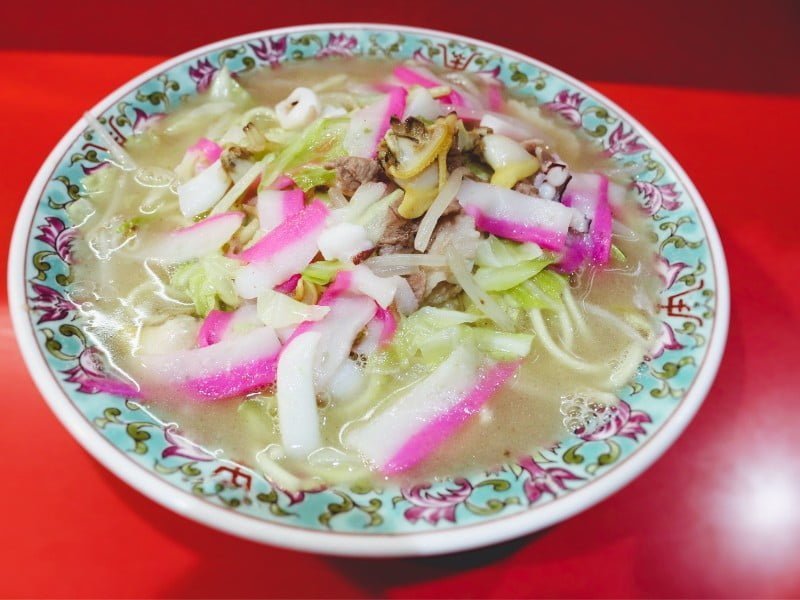
What To Eat and Drink in Sasebo, Japan
From its world-famous burgers to exquisite traditional Japanese fare, here’s a guide to what you should eat and drink while visiting this dynamic city.
Iconic Eats
1. Sasebo Burger A must-try in Sasebo, this burger isn’t just a meal; it’s a part of the city’s identity. Born from the American naval presence, the Sasebo Burger is known for its hand-formed patties, fresh, local ingredients, and a variety of unique toppings. Each burger joint in the city adds its own twist, making this dish a local culinary adventure.
2. Sushi and Sashimi Given its coastal location, Sasebo boasts fresh seafood that rivals any in Japan. The sushi and sashimi here are top-notch, with options ranging from tuna to more exotic local fish, served at traditional sushi bars and modern restaurants alike.
Local Delicacies
3. Champon Originally from Nagasaki, champon has found a special home in Sasebo. This noodle soup is rich with a seafood broth and loaded with a variety of seafood, vegetables, and pork. It’s a hearty, comforting dish perfect for Sasebo’s cool evenings.
4. Sara Udon Crispy noodles topped with a thick sauce of seafood, pork, and vegetables make Sara Udon a delightful meal. This dish perfectly showcases the blend of textures and flavors that Nagasaki cuisine is famous for.
Street Food and Snacks
5. Yaki Curry Baked curry rice topped with cheese and sometimes a breaded pork cutlet, Yaki Curry is a beloved local dish that reflects the Japanese take on Western flavors. It’s savory, hearty, and utterly satisfying, especially popular in cafes and small eateries throughout the city.
6. Ika (Squid) Grilled or fried, squid is a popular snack throughout Japan and Sasebo is no exception. Enjoy it at a local festival or a street side stall, seasoned simply with salt and maybe a squeeze of lemon.
Sweets and Desserts
7. Castella Cake While not native to Sasebo, Castella cake is a popular souvenir in Nagasaki prefecture. This sponge cake was brought to Japan by Portuguese merchants and has a lovely, light texture that pairs perfectly with green tea.
8. Matcha Ice Cream For a refreshing treat, try matcha ice cream. Its rich, slightly bitter green tea flavor is a favorite among locals and tourists alike and reflects the traditional Japanese love for all things tea.
Beverages
9. Sake No Japanese dining experience is complete without sake, and Sasebo has several local breweries that produce this iconic rice wine. Sample different types to find your favorite, from smooth and light to rich and umami-packed.
10. Shochu A stronger alternative to sake, shochu is a distilled spirit that is also popular in Sasebo. It can be made from barley, sweet potatoes, or rice, and is perfect for sipping alongside a hearty meal.
11. Green Tea Sasebo, like the rest of Japan, has a deep culture of tea drinking. Local cafes and restaurants often offer a variety of green teas, from the standard sencha to more elaborate blends like gyokuro or genmaicha.
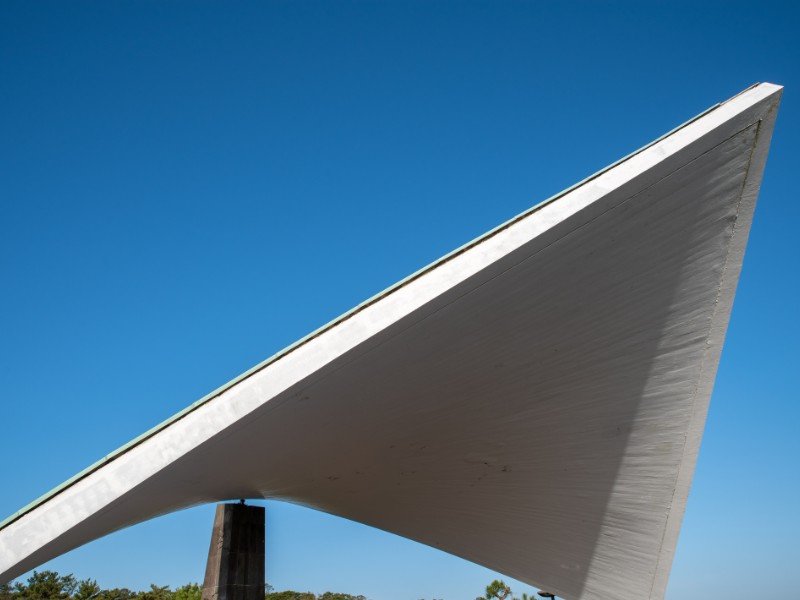
Tours For Visitors To Sasebo, Japan
Here’s your mini travel guide to the best tours in Sasebo, ensuring a memorable and enriching experience during your visit.
Historical and Cultural Tours
1. Sasebo Naval Base Tour Gain exclusive insights into Sasebo’s strategic importance in global maritime history with a guided tour of the Sasebo Naval Base. This tour typically includes visits to historical ships, the naval museum, and an overview of the base’s impact on regional security. It’s a unique opportunity to understand the military backdrop that shaped much of Sasebo’s 20th-century narrative.
2. Walking Tour of Yonkacho Arcade Step back in time with a walking tour of the historic Yonkacho Arcade in downtown Sasebo. Explore traditional shops that have been in business for generations, sample local snacks, and learn about the post-war economic boom that transformed the cityscape. This tour offers a personal look into the everyday lives of Sasebo’s residents past and present.
Nature and Adventure Tours
3. Kujuku Islands Boat Tour Embark on a scenic cruise around the Kujuku Islands, an archipelago of 208 islets that boast breathtaking natural beauty. These tours offer opportunities for photography, bird watching, and occasionally snorkeling, allowing you to experience the tranquil and pristine environment up close.
4. Saikai National Park Hiking Tour Explore the rugged landscapes of Saikai National Park on a guided hiking tour. Discover hidden waterfalls, serene walking paths, and panoramic views of the region’s karst mountains. These tours are great for nature lovers looking to immerse themselves in Sasebo’s lush greenery and vibrant ecosystems.
Culinary Tours
5. Sasebo Burger Crawl No visit to Sasebo is complete without tasting its famous Sasebo Burgers. Join a guided burger crawl to try different variations of this beloved local specialty at various eateries across the city. Learn about the American influence on local cuisine and why these burgers are a point of pride in Sasebo.
6. Local Brewery Tour For those interested in local spirits and brews, a tour of a Sasebo brewery offers insights into the craft of making Japanese beer and sake. Enjoy tastings, learn about the brewing process, and hear about the traditions of alcohol production in Japan.
Relaxation and Leisure Tours
7. Huis Ten Bosch Theme Park Tour Spend a day at Huis Ten Bosch, a Dutch-themed amusement park that recreates a Netherlands town. This tour includes guided walks through the park’s attractions, including beautiful gardens, water shows, and cultural exhibits, along with plenty of free time to explore on your own.
8. Sunset Cruises Take a relaxing sunset cruise along Sasebo’s picturesque coastline. These tours are perfect for winding down after a day of sightseeing, offering stunning views of the sunset over the East China Sea accompanied by light refreshments.
Educational and Interactive Tours
9. Ceramic Workshop in Hasami Travel to nearby Hasami, renowned for its pottery, for a hands-on ceramic-making workshop. Learn the local techniques that have been passed down through generations and create your own pottery piece to take home as a unique souvenir.
10. Sasebo City Museum and Cultural Center This tour is ideal for history buffs and cultural enthusiasts interested in learning more about Sasebo’s development, from its early days as a small fishing village to its role in international naval history. The museum tour is often combined with cultural performances or workshops that showcase regional arts and crafts.
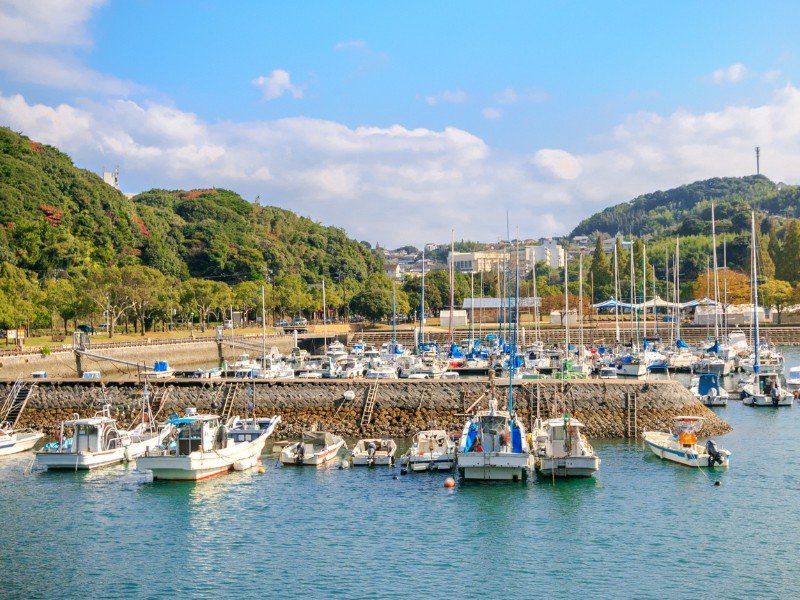
Sasebo Accommodations Guide: Hotels, Guesthouses and Hostels
From elegant hotels with panoramic views to cozy guesthouses rich with local charm, here’s a detailed travel guide to the best places to stay in Sasebo.
Luxury Hotels
1. Hotel Nikko Huis Ten Bosch Situated adjacent to the Huis Ten Bosch theme park, this luxurious hotel offers spacious rooms with European-style decor and modern amenities. Guests can enjoy on-site dining options that range from traditional Japanese to international cuisine, an indoor pool, and easy access to the theme park’s attractions.
2. Quintessa Hotel Sasebo Located in the heart of the city, Quintessa Hotel Sasebo combines comfort with convenience. It features elegantly furnished rooms, a restaurant serving a mix of Japanese and Western dishes, and a relaxing public bath, perfect for unwinding after a day of sightseeing.
Mid-Range Hotels
3. Sasebo Washington Hotel This hotel is ideally positioned for travelers looking to explore the city’s attractions, including the Sasebo shopping district and the Saikai Pearl Sea Resort. It offers clean, comfortable rooms at reasonable prices, with breakfast included.
4. Central Hotel Sasebo Offering a blend of comfort and value, Central Hotel Sasebo provides well-equipped rooms, complimentary WiFi, and is located conveniently close to transport links and local dining spots. It’s a great base for both business and leisure travelers.
Budget Accommodations
5. Sasebo Green Hotel A budget-friendly option, Sasebo Green Hotel offers basic but clean accommodations with all the necessary amenities, including free internet access. It’s ideal for travelers who want a comfortable place to stay without overspending.
6. Leo Plaza Hotel Sasebo For those watching their wallets, Leo Plaza Hotel is a perfect choice. Offering compact, efficient rooms at low rates, the hotel still provides plenty of comforts, such as free WiFi and on-site dining.
Guesthouses and Hostels
7. Guesthouse Keramiek A charming option, Guesthouse Keramiek offers a homey feel with its uniquely decorated rooms and friendly atmosphere. It’s a favorite among backpackers and young travelers for its affordability and the communal experiences it fosters.
8. 328 Hostel & Lounge For a youthful and modern stay, 328 Hostel & Lounge is highly recommended. It provides both dormitory-style and private rooms, a shared lounge area perfect for meeting other travelers, and kitchen facilities. It’s ideal for those looking to save money and make friends along the way.
Traditional Stays
9. Ryokan Yamanoren For a traditional Japanese experience, Ryokan Yamanoren offers tatami-floored rooms, futon beds, and onsen (hot spring) facilities. Guests can enjoy authentic Japanese cuisine and the tranquil atmosphere typical of a Japanese inn.
10. Seaside Hotel Mimatsu OOETEI This seaside ryokan allows guests to enjoy spectacular ocean views and traditional hospitality. The hotel features Japanese-style rooms, a public bath facing the sea, and kaiseki (traditional multi-course dinner) meals featuring local seafood.
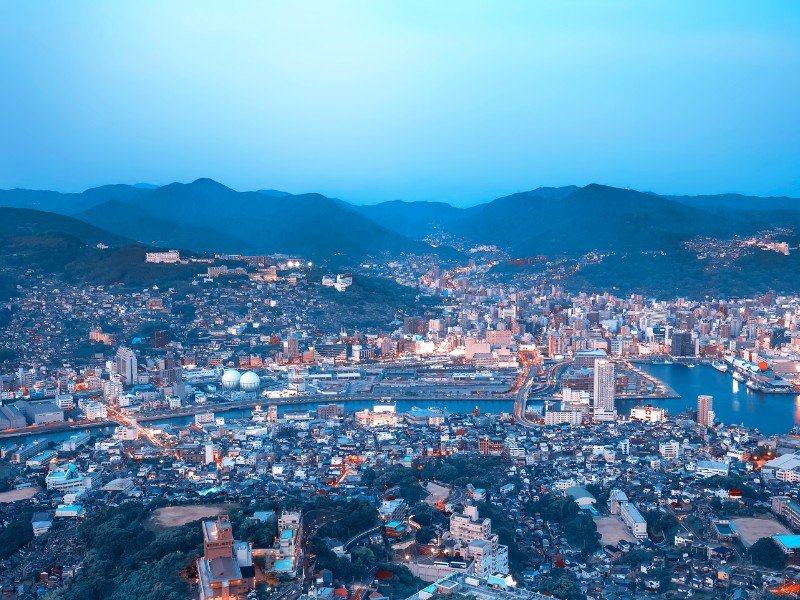
Day Trips From Sasebo, Japan
From stunning nature reserves and historic sites to vibrant cities and peaceful islands, here’s a list of the best day trips to consider during your stay in Sasebo.
1. Nagasaki
Just a short drive or train ride away, Nagasaki is a city steeped in history and culture. Visit the poignant Peace Park and Atomic Bomb Museum to understand the city’s tragic past. Don’t miss Glover Garden, an open-air museum showcasing Meiji-period western-style houses. Wrap up your visit with a walk through the vibrant Chinatown, the oldest in Japan, for some delicious street food.
2. Huis Ten Bosch
Located very close to Sasebo, Huis Ten Bosch is a Dutch-themed amusement park that replicates the Netherlands with its canals, iconic windmills, and tulip gardens. The park offers a range of attractions, including rides, museums, and seasonal festivals like the tulip festival in spring and illuminations in winter. It’s a fantastic place for families and couples alike. Additionally, the park hosts concerts and fireworks shows that are well worth checking out.
3. Goto Islands
Take a ferry from Sasebo to the remote Goto Islands, known for their stunning beaches and clear waters, making them perfect for snorkeling and diving. Explore the rich history of hidden Christian sites, which are part of the UNESCO World Heritage listing. The islands also offer beautiful hiking trails and traditional villages to explore. Enjoy the freshest seafood at local restaurants before heading back to the mainland.
4. Arita and Imari
Famous for their centuries-old pottery traditions, Arita and Imari are must-visit destinations for ceramics enthusiasts. Take guided tours of pottery kilns where you can see artisans at work and even try your hand at making your own pottery. The towns are picturesque, with shops selling beautifully crafted ceramics at every turn. The Arita Porcelain Park, a replica of a traditional German castle, showcases some of the finest porcelain art.
5. Kujuku Islands
These 208 scattered islands can be explored via a relaxing boat cruise from Sasebo. The tour offers stunning views of untouched natural beauty and opportunities for wildlife photography. On some islands, you can disembark, hike, and enjoy a picnic. This is a perfect trip for nature lovers looking to escape the hustle and bustle of city life.
6. Fukuoka
Just a couple of hours by car or train, Fukuoka is one of Kyushu’s most dynamic cities. Explore the bustling Canal City Hakata, a large shopping and entertainment complex with a canal running through it. Visit the ancient shrines and temples, including the serene Dazaifu Tenmangu, dedicated to the god of learning. Don’t leave without trying the famous Hakata ramen at one of the local ramen stalls.
7. Kumamoto
Home to the impressive Kumamoto Castle, which is considered one of the most formidable castles in Japan, despite damage from recent earthquakes. The Suizenji Jojuen Garden is another highlight, offering meticulously landscaped gardens perfect for a leisurely stroll. For a taste of local flavor, try Kumamoto’s famous horse sashimi if you’re adventurous. The city also offers various shopping and dining options to enjoy a full day out.
8. Unzen Hot Springs
Relax at the Unzen Hot Springs, nestled in the scenic Mount Unzen National Park. The area is known for its hellish landscapes where hot steam vents from the earth, and the therapeutic properties of its hot spring waters. Hiking opportunities abound in the national park, with trails leading through volcanic landscapes and lush forests. It’s an ideal retreat for those seeking tranquility and rejuvenation.
9. Karatsu
Visit Karatsu, a coastal town known for its castle, beautiful beaches, and the annual Karatsu Kunchi festival, which features colorful floats paraded through the town. Explore the Karatsu Castle for panoramic views of the surrounding area. The town is also famous for its unique Karatsu-yaki pottery. Enjoy a leisurely day exploring the quaint streets and sampling local cuisine by the seaside.
10. Yanagawa
Experience a peaceful boat ride down the historic canals of Yanagawa, an hour’s drive from Sasebo. Known as the “Venice of Kyushu,” this charming town is perfect for a relaxing day out. Explore the old samurai district and visit the former residence of the famous Japanese poet, Kitahara Hakushu. Enjoy a local specialty, unagi no seiro-mushi (steamed eel), before heading back.

Sasebo Transportation Guide
Whether you’re planning to explore the city’s attractions or venture into the surrounding areas, here’s all you need to know about transportation in Sasebo.
Arriving in Sasebo
1. By Air The nearest airport to Sasebo is Nagasaki Airport, located about 50 kilometers away. From there, you can take a bus directly to Sasebo, which takes approximately 1.5 hours. Alternatively, Fukuoka Airport is a larger international hub and offers additional connectivity, though it is further away, requiring a train or bus transfer to Sasebo.
2. By Train Sasebo is well connected by rail. The Sasebo Line connects the city to Nagasaki, and the Omura Line provides access from Fukuoka via Haiki. For a faster option from Fukuoka, the Limited Express Midori/Huis Ten Bosch train makes a convenient choice, offering a comfortable and scenic ride directly into Sasebo Station.
Getting Around Sasebo
3. Sasebo Bus The local bus network in Sasebo is extensive and provides an affordable way to travel around the city and to nearby attractions. Buses are frequent, and routes cover major tourist spots, shopping districts, and residential areas. Timetables and route maps are available at bus stations and online, making it easy to plan your journey.
4. Taxis Taxis in Sasebo are a convenient but more expensive option for getting around, especially if you are traveling in a group or with heavy luggage. Taxi stands are located outside Sasebo Station and major hotels, and they can be hailed on the street. Most taxi drivers do not speak English, so it’s helpful to have your destination written in Japanese or show a map.
5. Rental Cars For those looking to explore at their own pace or planning to visit remote areas, renting a car is a good option. Several rental agencies are available at the airport and in the city, including international brands. Driving in Sasebo is relatively easy with well-maintained roads and signage in both Japanese and English. Remember that driving is on the left side of the road in Japan.
6. Bicycles Sasebo’s relatively compact city center and scenic surroundings make it ideal for exploring by bicycle. Many hotels offer bike rentals to their guests, and there are several rental shops in the city. Biking is a great way to enjoy Sasebo’s beautiful parks and waterfront areas at a leisurely pace.
7. Walking Many of Sasebo’s attractions are located within walking distance of each other, especially around the central shopping districts and the port area. Walking is not only a healthy option but also allows you to discover hidden gems such as small local cafes and shops not accessible by public transport.
Day Trips from Sasebo
8. Ferries Sasebo is a gateway to the many islands of the Kujuku Islands archipelago. Regular ferry services are available from Sasebo Port, offering day trips and longer excursions to these scenic islands. This is a must-do activity to truly experience the natural beauty surrounding Sasebo.
9. Trains for Regional Exploration For further afield trips, the train services connecting Sasebo to other cities such as Nagasaki and Fukuoka are efficient and offer a scenic route through the countryside. The JR Pass can be a cost-effective option for tourists planning to travel extensively by train.
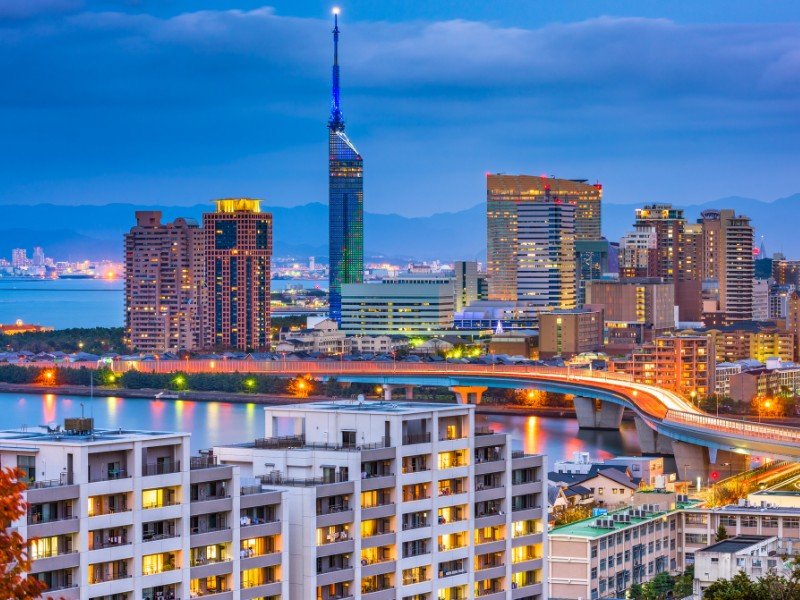
Where To Visit After Your Trip To Sasebo?
Here’s a list of the top 10 destinations to consider visiting after your stay in Sasebo.
1. Nagasaki
Just a short drive or train ride away, Nagasaki is steeped in history and culture. Visit the Peace Park and the Atomic Bomb Museum to understand its poignant World War II history. Explore Dejima and Glover Garden to get a sense of Nagasaki’s historical significance as a port city open to foreign trade during Japan’s period of isolation. The city also offers wonderful panoramic night views from Mount Inasa.
2. Fukuoka
As Kyushu’s largest city, Fukuoka is known for its ancient temples, beautiful parks, and dynamic food scene. Stroll through the ruins of Fukuoka Castle and relax in the traditional Japanese gardens of Ohori Park. Don’t miss trying the famous Hakata Ramen, where the dish originated. The city is also great for shopping, especially at Canal City Hakata, a large mall with a canal running through it.
3. Kumamoto
Home to the iconic Kumamoto Castle, which is considered one of Japan’s three premier castles despite suffering damage in a 2016 earthquake, Kumamoto offers rich history and vibrant gardens like Suizenji Jojuen. Explore the contemporary art scene and regional history at the Kumamoto Prefectural Museum of Art. The city is also known for its delicious Wagyu beef, which is a must-try. For nature lovers, a visit to Mount Aso, an active volcano, provides a breathtaking experience.
4. Hiroshima
Travel a bit further to Hiroshima, a city that, like Nagasaki, has a moving WWII history to share. Visit the Hiroshima Peace Memorial Park and Museum, which commemorate the victims of the atomic bomb. Explore Miyajima Island, famous for its floating torii gate and scenic hikes. Hiroshima is also celebrated for its okonomiyaki, a savory pancake that is a local specialty.
5. Yakushima
If you’re looking for a nature escape, Yakushima is an enchanting island off the southern coast of Kyushu known for its ancient cedar forests, which inspired the Studio Ghibli film “Princess Mononoke.” Hike through Yakushima’s lush, mossy forests to see trees that are thousands of years old. The island also offers hot springs and beautiful waterfalls. Its remote beauty makes it a perfect spot for those looking to disconnect and immerse themselves in nature.
6. Beppu
Famous for its hot springs, Beppu offers one of Japan’s most iconic onsen experiences. Visit the “Hells” of Beppu—seven spectacular hot springs that are for viewing rather than bathing. Try sand bathing, where you’re buried in naturally heated sand, or enjoy a traditional mud bath. Beppu’s coastal location also provides fresh seafood, complementing its spa-town vibe.
7. Takachiho
Takachiho is a mythological place in Japanese folklore located in the northern part of Miyazaki Prefecture. It’s famous for the stunning Takachiho Gorge, where you can rent rowboats to view the waterfall amidst volcanic cliffs. Watch a traditional Kagura dance performance to learn about the area’s myths. The town is surrounded by mountains and offers scenic hiking paths with breathtaking views.
8. Ibusuki
Known for its unique sand baths, Ibusuki is a must-visit for those seeking a different kind of spa experience. Visitors are buried in naturally heated sand which is said to have healing properties. Explore the beautiful beaches and taste the local specialty, black vinegar, which is used in many dishes here. The area is also known for its lush flower gardens, which bloom year-round.
9. Saga
Experience the tranquility of rural Japan in Saga, known for its pottery towns like Arita and Karatsu. These towns host ceramic festivals where you can buy local wares directly from the artisans. Saga Castle and its historical park provide a glimpse into the feudal past of Japan. The region’s balloon festival in autumn is a breathtaking sight, with colorful hot air balloons dotting the sky.
10. Shimabara
Explore the history and natural beauty of Shimabara, located on the Shimabara Peninsula. Visit Shimabara Castle for its historical exhibits and beautiful surrounding gardens. The area is known for its spring water canals and carp that swim through the city. Hike up Mount Unzen and later relax in the Unzen hot springs, offering a rejuvenating experience.
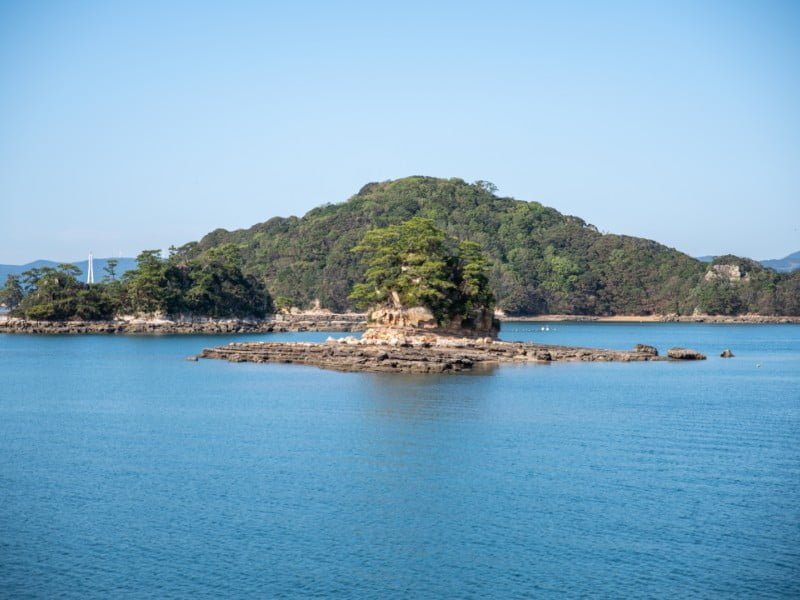
Essential Sasebo Travel Questions Answered: Practical Planning Tips, Island Views, Burger Wisdom & Easy Day-Trip Ideas
How many days do you really need in Sasebo?
It depends. If you’re doing the highlights—Kujukushima cruise, one observatory, a burger crawl, and a quick city wander—two days and one night feels comfortable.
If you want a slower pace, add a third day for Huis Ten Bosch or a day trip to Hirado. Sasebo is the kind of place where “one more sunset viewpoint” is a very real temptation.
Is Sasebo worth visiting if I’m already going to Nagasaki or Fukuoka?
Absolutely. Sasebo doesn’t try to out-historic Nagasaki or out-energize Fukuoka. It wins on coastal scenery, easy island access, and that quirky Japanese-American flavor that shows up in food and everyday city life.
If you like places that feel a little under-the-radar but still easy to travel, Sasebo is a great Kyushu curveball.
Are the Kujukushima “99 Islands” actually 99?
Nope. The name is more poetic than mathematical. The Kujukushima area is commonly called the “99 Islands,” but there are over 200 islands/islets spread along the coast, and the region sits within Saikai National Park.
That’s part of the fun—you’re not looking at one perfect postcard island. You’re looking at an entire textured seascape.
Which is better: a cruise, kayaking, or viewpoints for Kujukushima?
Short answer: do two of the three if you can.
A cruise gives you the big-picture wow without effort. Kayaking is for travelers who want quiet coves and a more intimate vibe. And the observatories (like Tenkaiho and Ishidake) are your cinematic overview spots.
If you only choose one, we’d pick a cruise plus one sunset viewpoint for maximum payoff with minimal logistics.
What’s the best time of year to visit Sasebo?
Yes—spring and autumn are the sweet spots if you want comfortable walking weather and clear views.
For a simple planning rule:
- March to May is great for mild temps and seasonal blooms.
- October and November are especially pleasant for clear skies, outdoor exploring, and autumn color.
Summer can be hot and humid, and Japan’s rainy season typically begins around June.
How do I get to Sasebo from Nagasaki Airport?
The easiest way is a direct airport bus when schedules line up. The ride is roughly 1 hour 15 minutes based on current route timetables.
If the timing doesn’t work, you can also connect by bus/train via major hubs. Either way, Sasebo is a manageable airport-to-city transfer by Kyushu standards.
Is Sasebo easy to explore without a rental car?
Mostly, yes. The city core, shopping arcades, and port area are very doable with walking, local buses, and taxis.
That said, a car becomes more tempting if you want to stack multiple viewpoints in one day or head out to more rural corners at your own pace. For most first-timers, though, you can absolutely build a solid Sasebo itinerary without driving.
Is Huis Ten Bosch worth it for adults, not just families?
Absolutely. Even if you’re not a theme-park person, the appeal here is the surreal Dutch city recreation, gardens, seasonal lighting, and evening atmosphere.
It’s especially good for couples, photographers, and anyone who loves strange-but-delightful cultural mashups. If you can swing it, staying into the evening for illuminations can shift it from “quirky daytime stop” to “unexpected highlight.”
What’s the story behind Sasebo burgers?
Sasebo burgers grew out of the city’s long relationship with the U.S. naval presence and evolved into a local specialty with handmade, made-to-order pride.
The fun is that there isn’t one official version. You’re basically eating a friendly rivalry between shops.
How many Sasebo burger places should I try?
Not really just one—if you’re a burger fan. We’d aim for two: one classic, one more “anything goes.”
Make it a mini crawl. Split a burger if you’re traveling with someone so you can compare without entering the nap zone.
What should I eat in Sasebo besides burgers?
Sasebo is a seafood city at heart, so sushi and sashimi are strong choices. But we’d also look for:
- Champon for a hearty Nagasaki-style noodle fix.
- Sara udon if you want texture and rich sauce.
- Yaki curry for something comfort-food cozy with a Western-Japanese twist.
This is a great city for mixing a “serious” seafood meal with one unapologetically fun burger stop.
Is Sasebo a good base for day trips?
Yes. It’s a convenient launch point for Hirado and other scenic coastal escapes. Island options also broaden your itinerary if you want a nature-heavy Kyushu stretch.
If you’re building a loop around northern Kyushu, Sasebo fits nicely as a two-night base that breaks up bigger-city travel.
Is Sasebo family-friendly?
Absolutely. Between aquarium time, gentle cruises, parks, and the generally easygoing pace, it’s a low-stress stop for families.
If you’re traveling with small kids, the “short activity, snack, scenic walk” rhythm works really well here.
What about accessibility and mobility in Sasebo?
It depends. The city center and major attractions like shopping arcades and some museums are relatively manageable. But observatories and nature viewpoints can involve slopes, uneven surfaces, or longer walks.
If mobility is a concern, we’d prioritize a cruise for island views and choose one easier-to-access viewpoint rather than trying to do them all.
Are there any safety concerns or etiquette tips to know?
Sasebo is generally very safe by Japan standards. The main etiquette consideration is being respectful around areas connected to the naval presence and avoiding intrusive photography in sensitive zones.
Beyond that, standard Japan travel manners apply: quiet voices on public transport, tidy behavior in shared spaces, and a little patience during busy seasonal weekends.
Sasebo Travel Guide: Final Thoughts
As your journey in Sasebo comes to an end, it’s hard not to feel enriched by the myriad of experiences this charming city has offered. From its scenic natural beauty and rich historical tapestry to its unique cultural fusions and delightful culinary treats, Sasebo has something that resonates with every traveler. Whether you spent your days exploring islands, tasting local delicacies, or soaking in the vibrant city life, Sasebo surely leaves you with memories to cherish.
A City of Surprises
Unexpected Delights: Who knew that a small city in Nagasaki could offer such an eclectic mix of attractions? Sasebo’s blend of Japanese tradition and American influence creates a cultural landscape that is both intriguing and inviting. The city’s ability to surprise and delight its visitors is perhaps its most charming trait.
Nature’s Playground
Island Adventures and More: The beauty of Sasebo extends far beyond its city limits, with the Kujuku Islands offering a serene escape into nature’s embrace. Whether you indulged in a tranquil boat ride or engaged in more active pursuits like hiking and snorkeling, the natural surroundings of Sasebo provided a perfect backdrop for adventure and relaxation.
Culinary Journey
A Taste of Local and Global Flavors: Sasebo’s culinary scene is a testament to its diverse influences. From the famous Sasebo burger to traditional Japanese dishes and fresh seafood, your palate was treated to an array of flavors that tell the story of the city’s eclectic heritage. Each meal was an opportunity to explore Sasebo’s unique culinary identity.
Lasting Impressions
Cultural Connections: Beyond the visual and gastronomic delights, Sasebo offered deep cultural connections. Whether it was through a festival, a historical tour, or simply interacting with the friendly locals, you likely felt a meaningful link to the city’s rich past and vibrant present.
Safe travels, and hope to see you back in Sasebo soon, where adventure awaits at every corner!
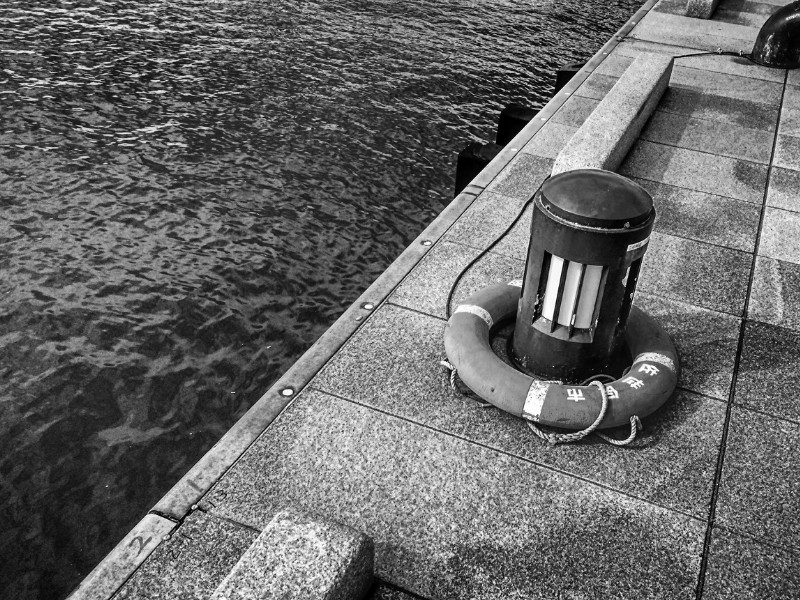
Ode To Sasebo
In Sasebo’s embrace, a traveler finds delight, Where history and beauty intertwine, day and night. Naval echoes whisper through the city’s core, As tales of seafaring heroes dance on the shore.
Amidst Kujukushima’s islands, a wondrous sight, Nature’s brushstrokes paint a vivid palette of light. Cruising through emerald waters, dreams take flight, As dolphins play and seabirds take their graceful flight.
Savor the flavors of Sasebo, a culinary delight, From mouthwatering burgers to seafood so bright. Champon noodles warm the soul, satisfying and warm, As taste buds dance with each vibrant, flavorful form.
Stroll through Sasebo’s streets, a journey in time, Where past and present harmoniously chime. Sasebo Park’s serenity invites a peaceful retreat, With blossoms in spring and tales of history to greet.
Day trips beckon, to Nagasaki’s profound embrace, Hiroshima’s resilience and its message of peace. From quaint islands to scenic mountain peaks, Exploration unfolds, memories that forever speaks.
Transportation weaves a tapestry of ease, Trains, buses, and ferries connecting with breeze. Amidst accommodations, a cozy and warm retreat, Resting weary souls and ensuring memories are complete.
In Sasebo’s heart, a traveler finds their bliss, An adventure that transcends the ordinary abyss. Immerse in the culture, embrace the city’s embrace, For in Sasebo’s embrace, wonders leave a lasting trace.
